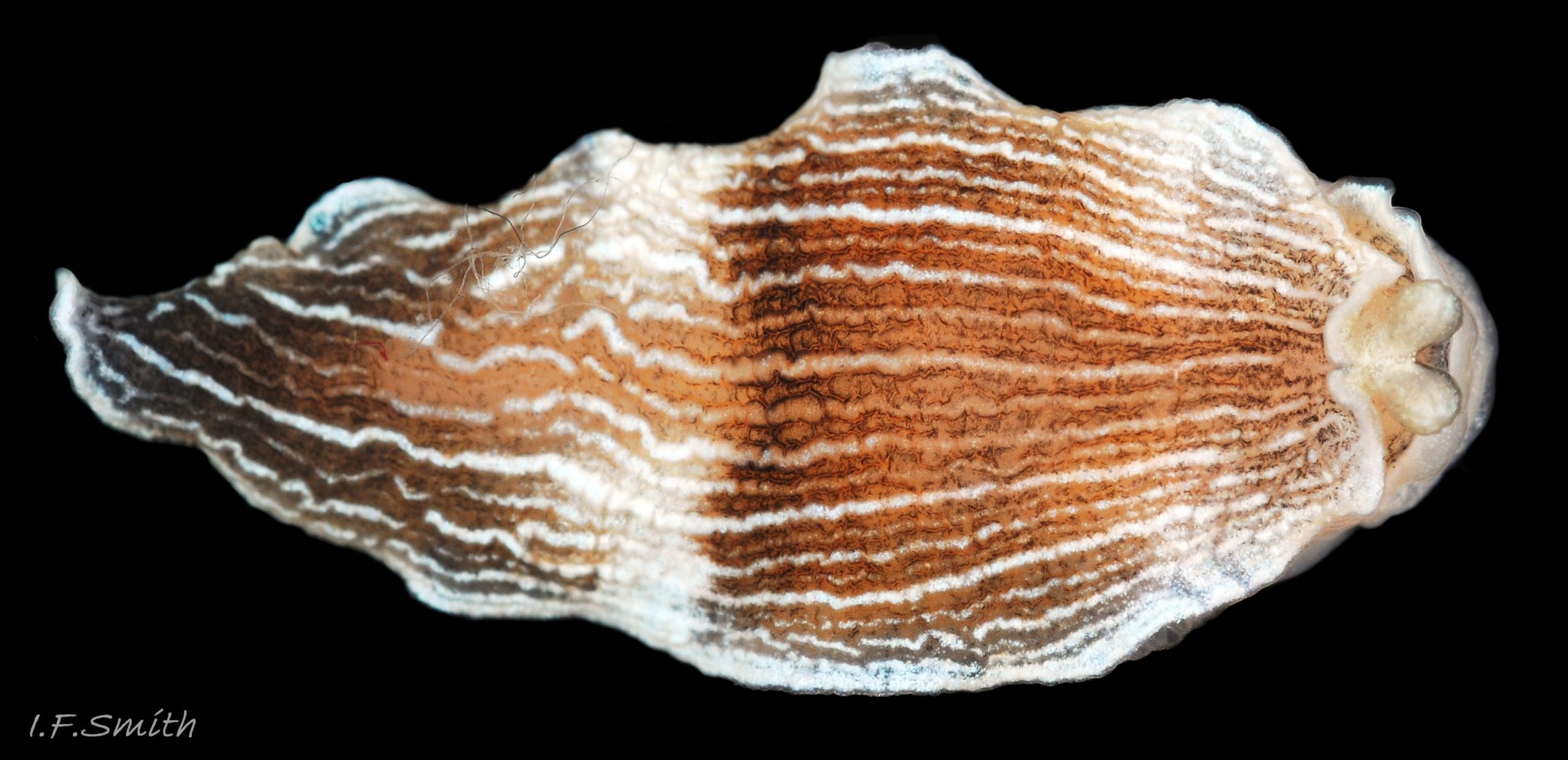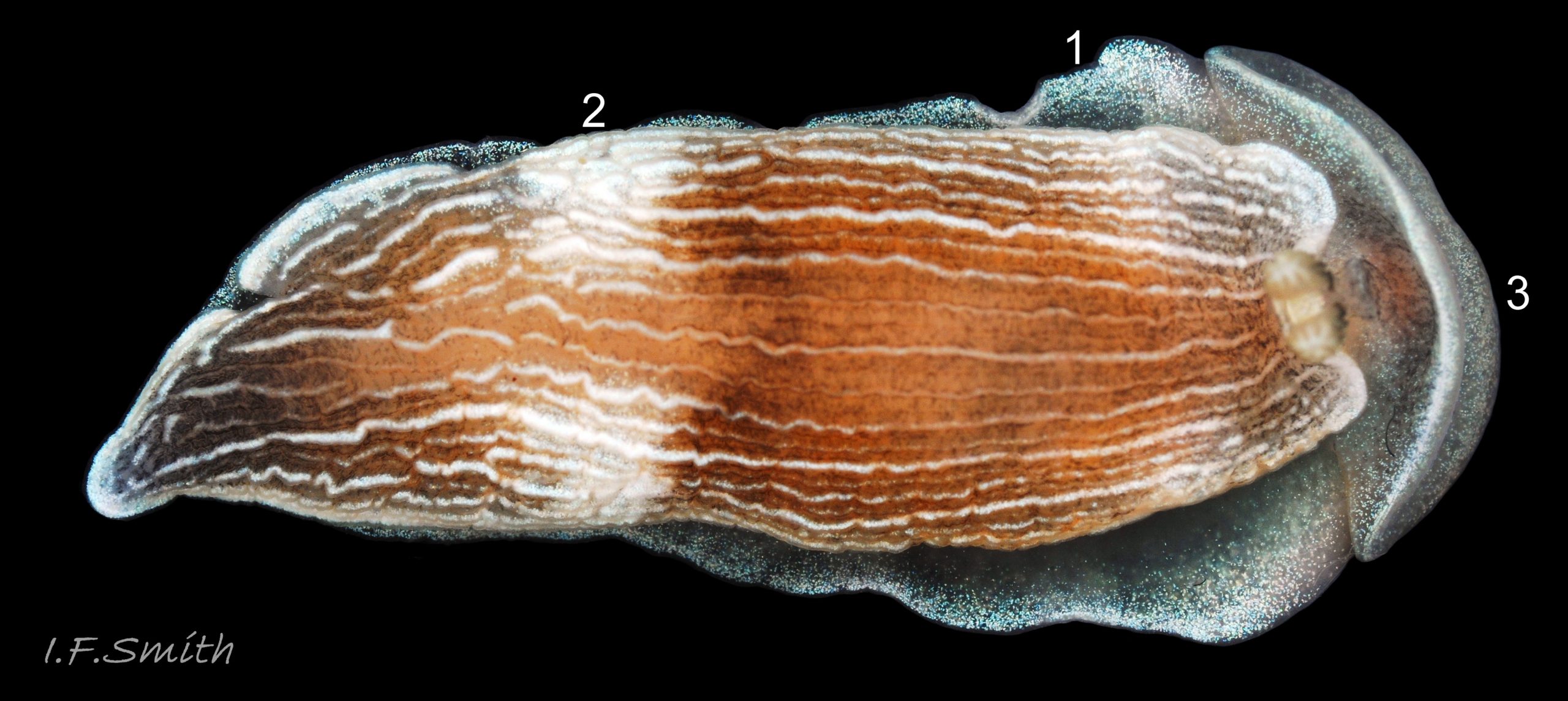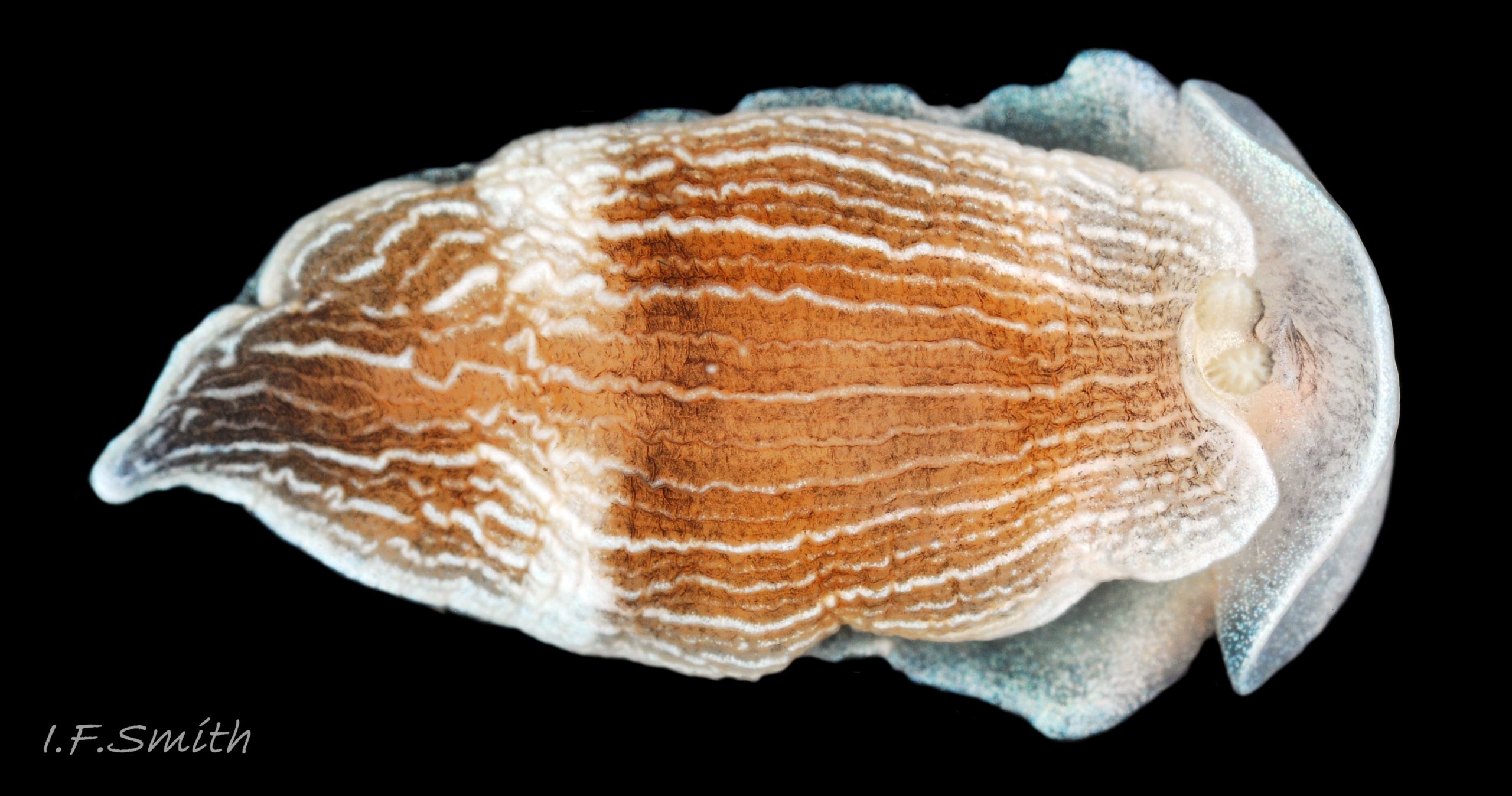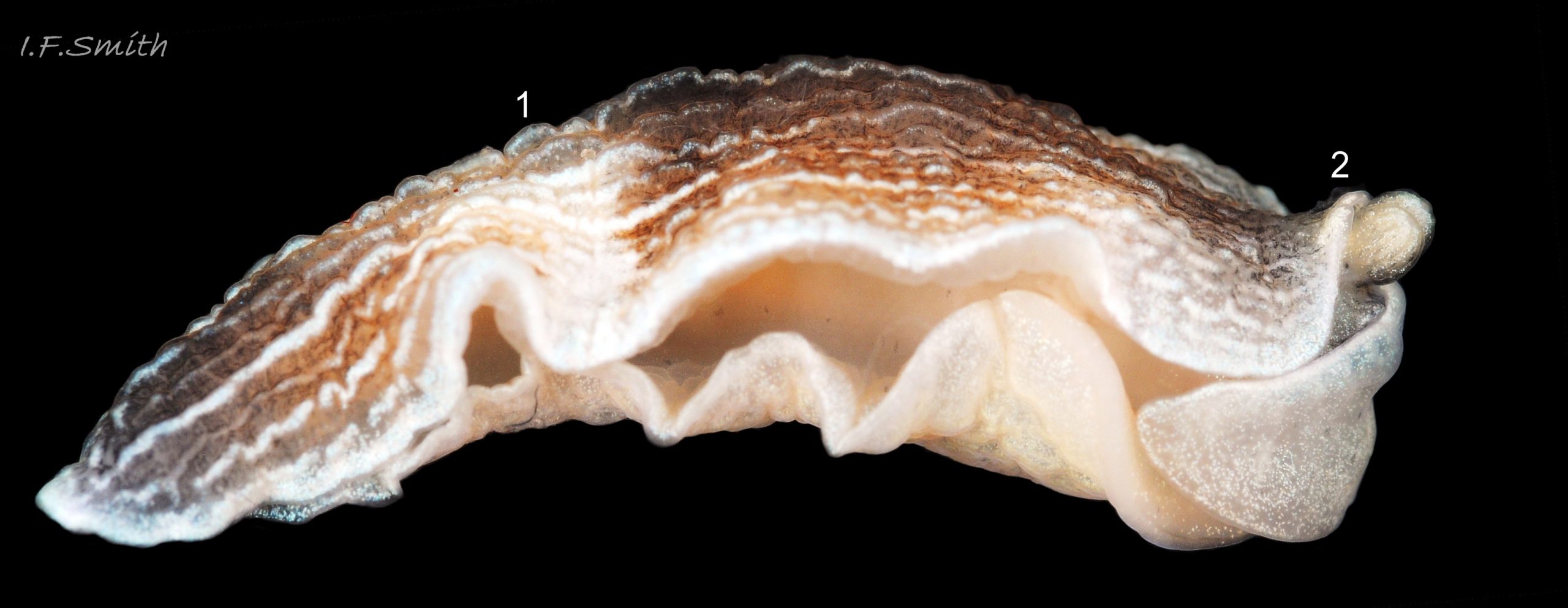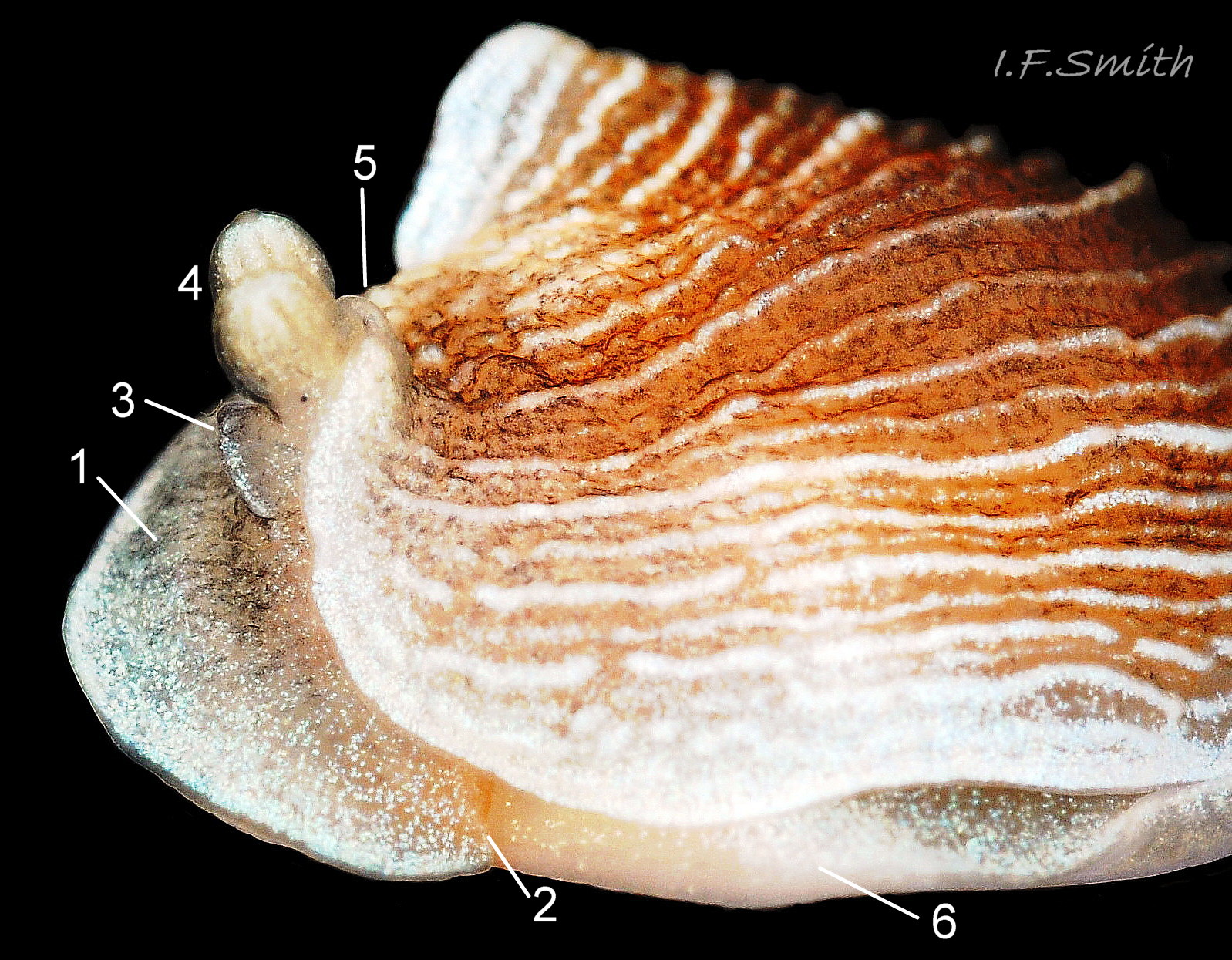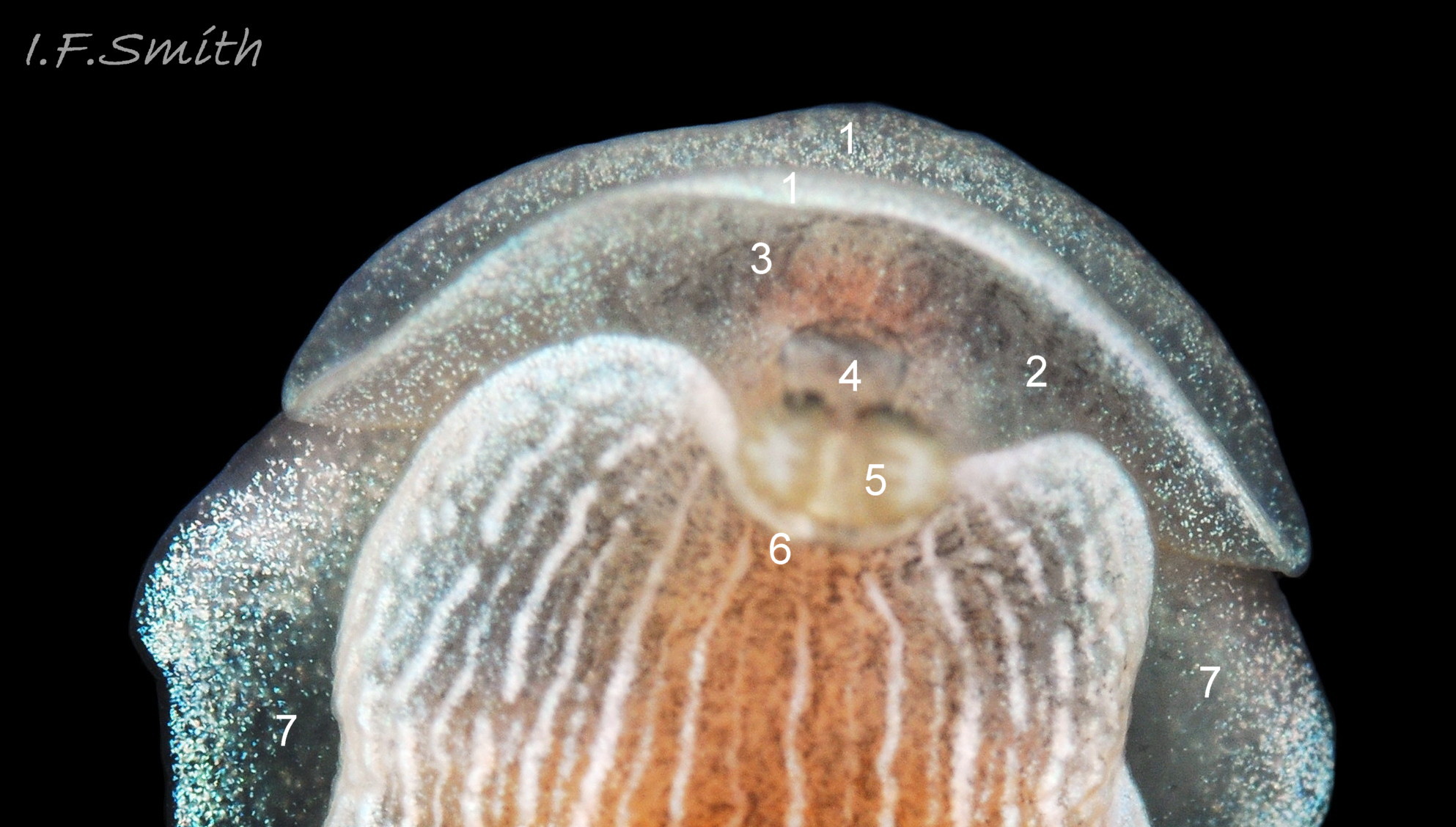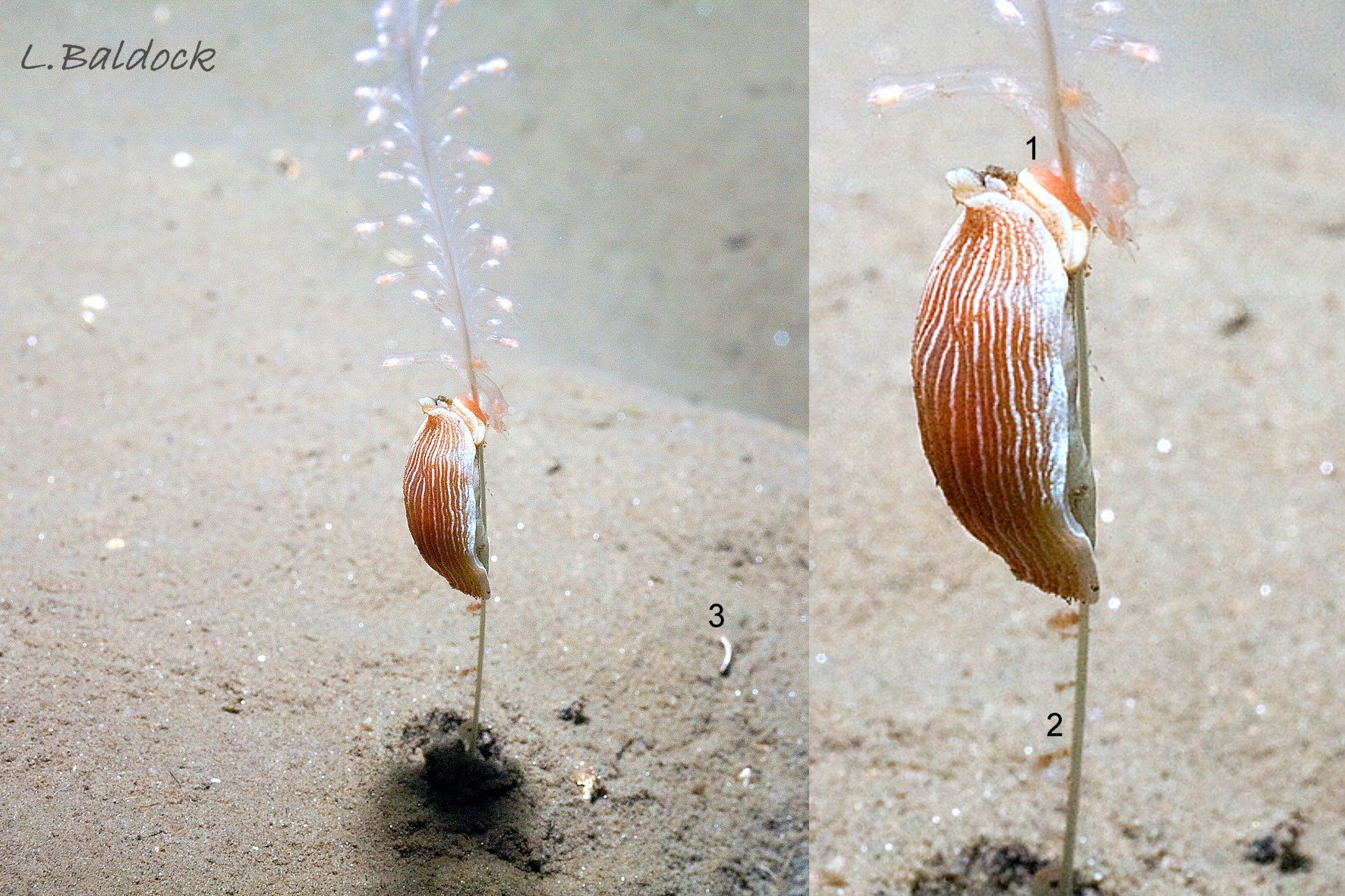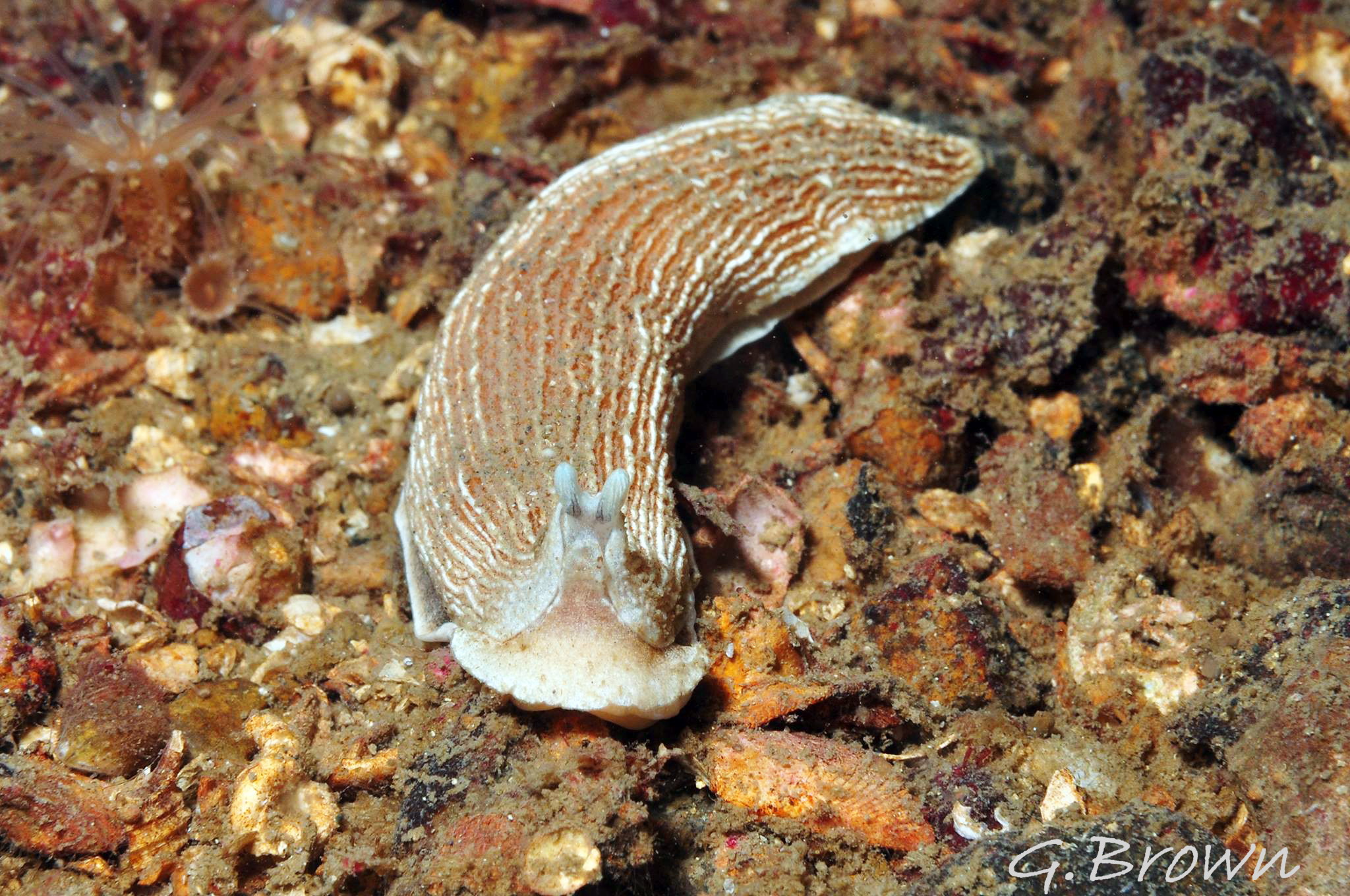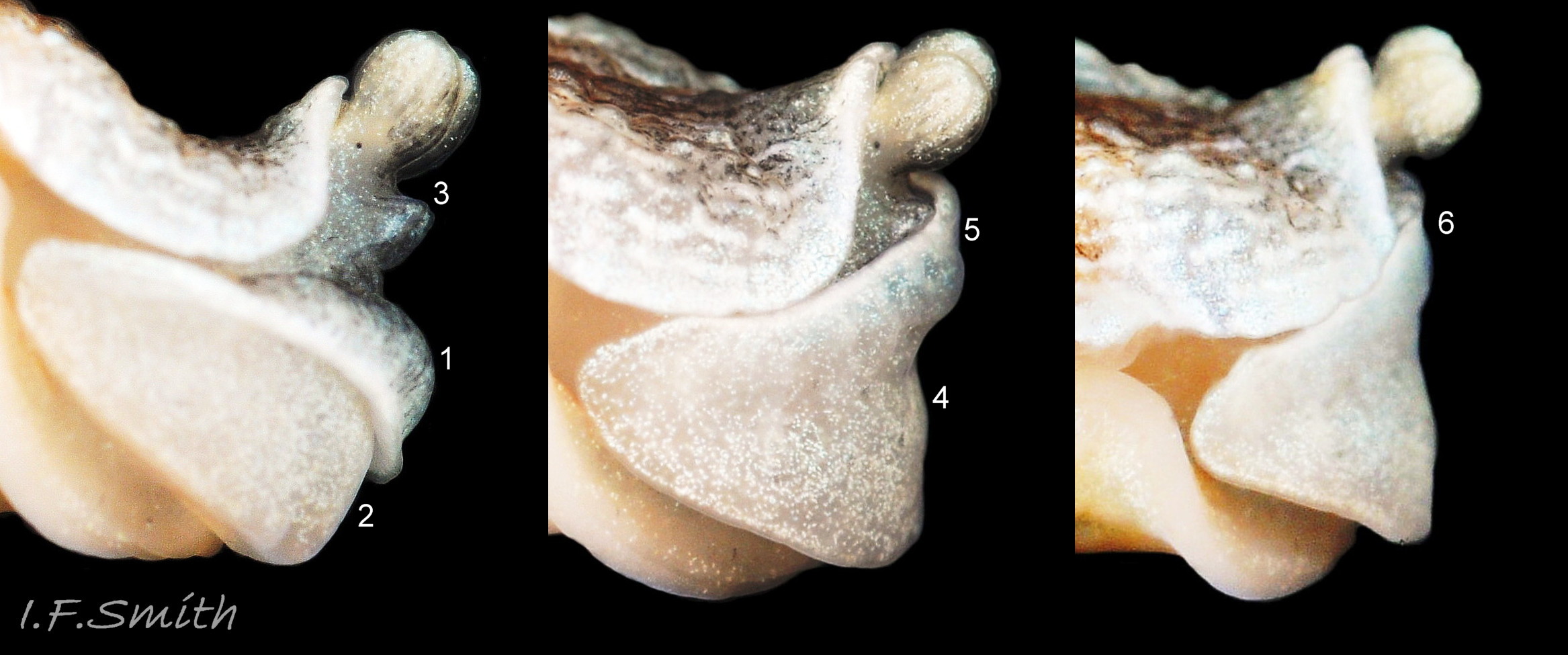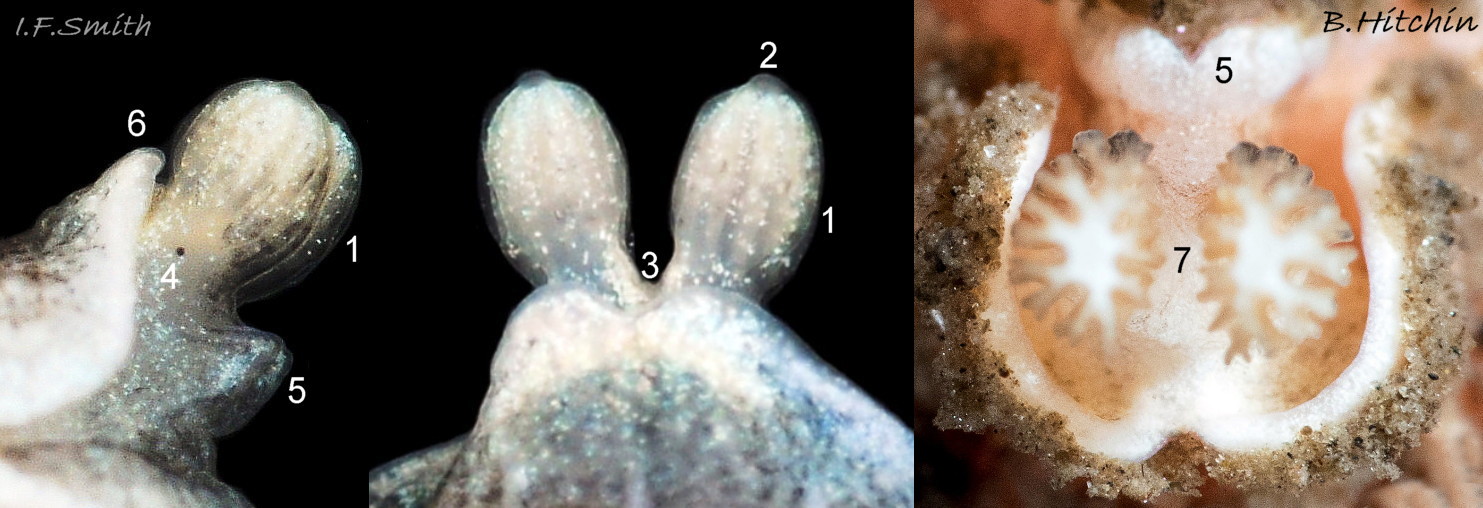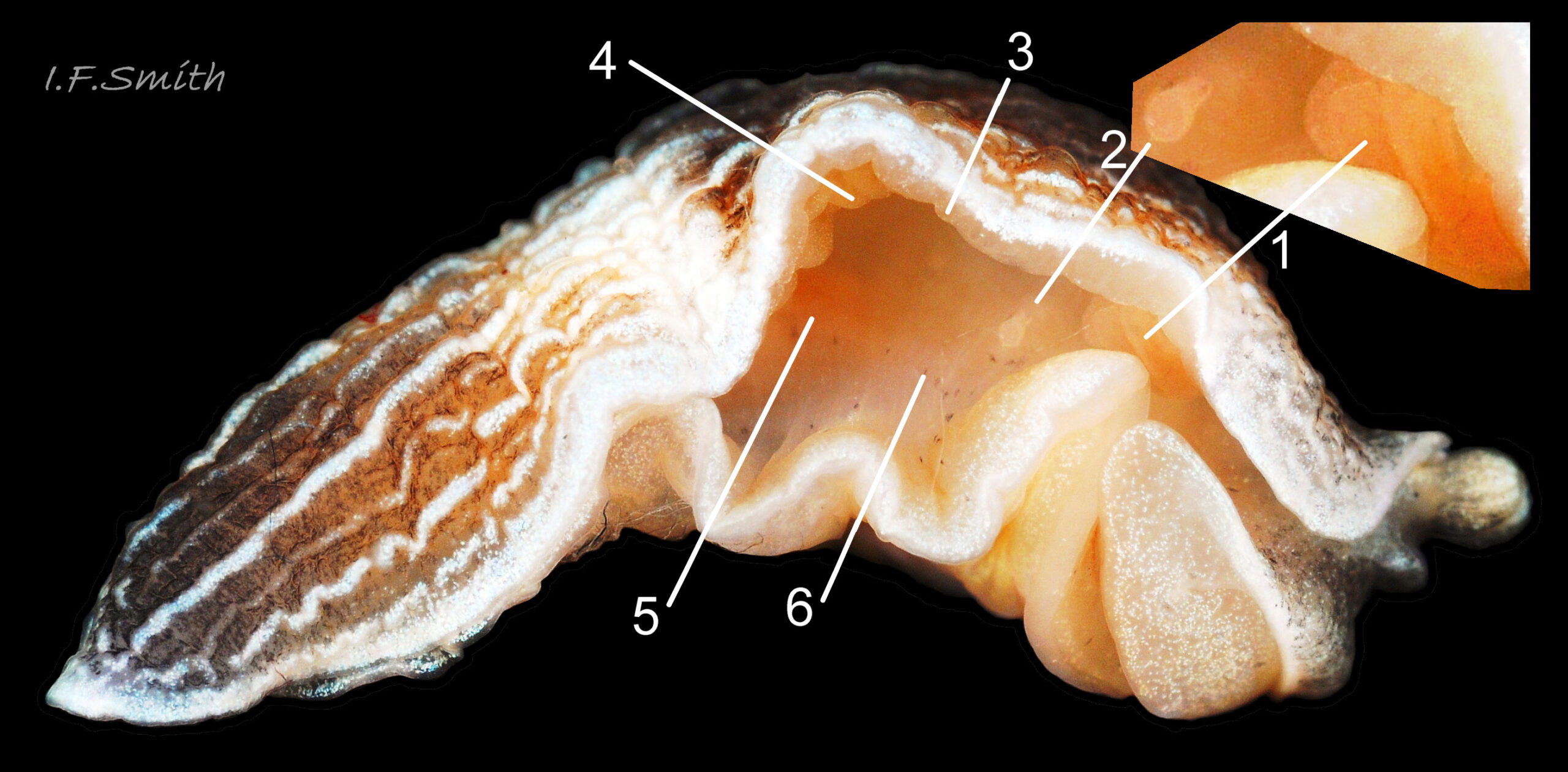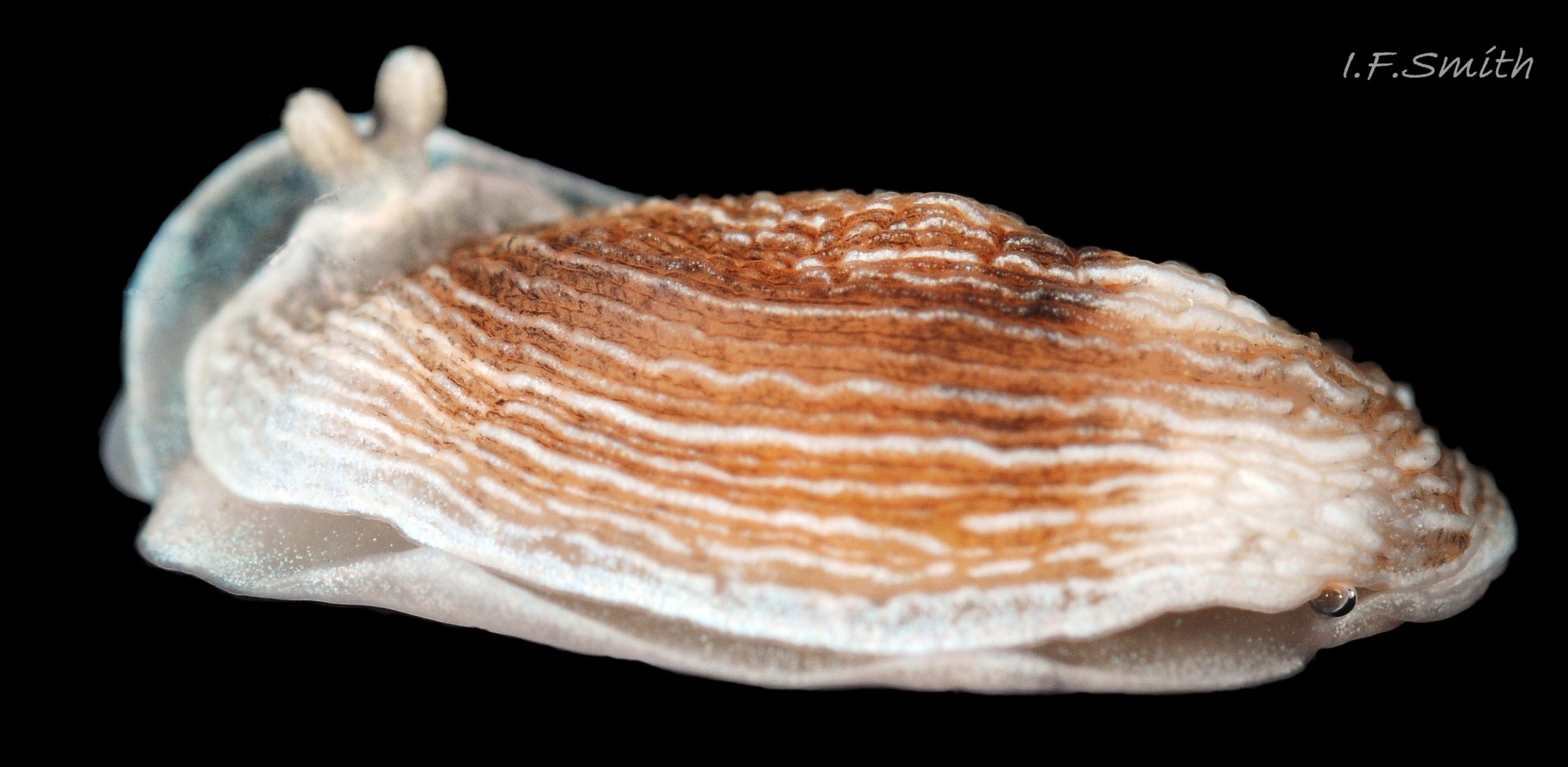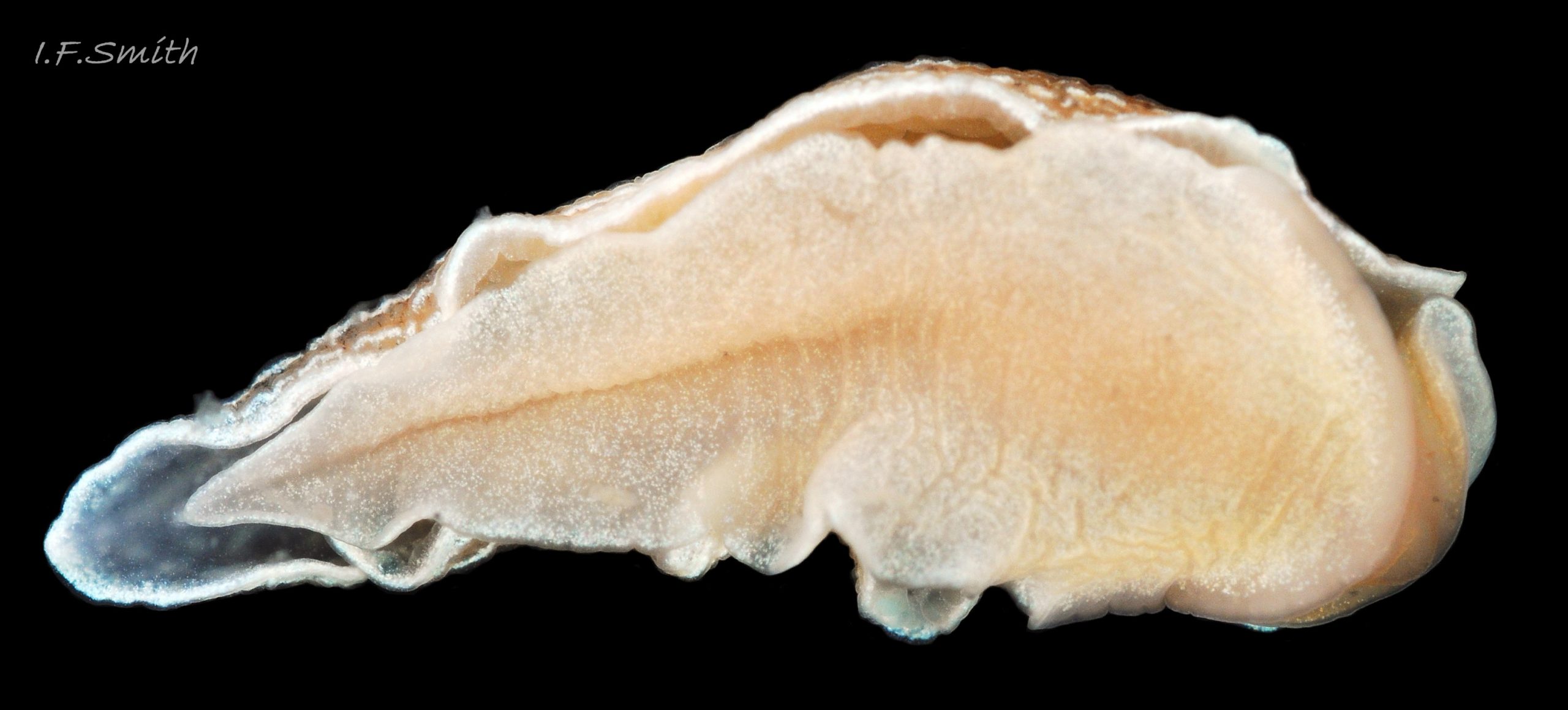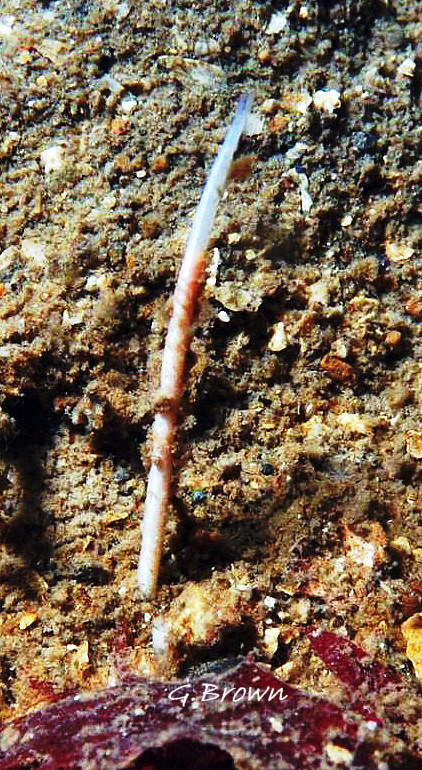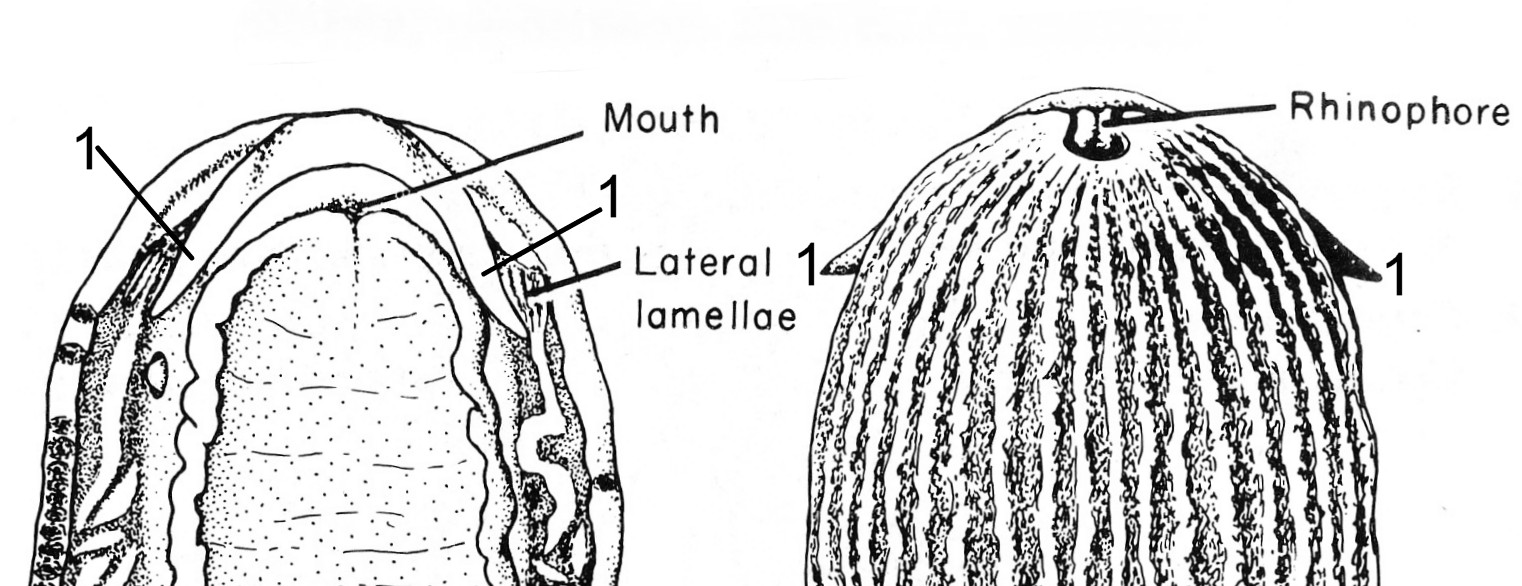Click image to enlarge with full caption. Main text below slider.
Armina loveni (Bergh, 1866)
Authors Ian Frank Smith (text) and Simon Taylor (fieldwork).
Current taxonomy: World Register of Marine Species (WoRMS) https://www.marinespecies.org/aphia.php?p=taxdetails&id=138804
Synonyms Pleurophyllidia loveni Bergh, 1866.
GLOSSARY below.
Among British species, A. loveni is unique in its external anatomy and mode of life, but there are closely similar Armina species elsewhere. It cannot be ruled out that DNA investigation might reveal more than one cryptic species in British waters.
Body
Up to 40 mm long, and covered by, in dorsal view, a lanceolate mantle, slenderest at the posterior 01 Armina loveni. It can contract from a slender outline 02 Armina loven. to a stout one 03 Armina loveni . The smooth brick-red surface has up to 50 irregularly wavy, white, longitudinal ridges 04 Armina loveni which are more or less continuous for the length of the mantle; strong ones alternating with weaker ones 03 Armina loveni . The mantle has a whitish peripheral border 03 Armina loveni that has many protruding translucent glands ventrally 05 Armina loveni. The front edge of the mantle is indented 01 Armina loveni and raised 04 Armina loveni to accommodate the protruding rhinophores. Some specimens have a broad, partial, transverse, paler zone near the anterior and one over half way along the mantle 02 Armina loveni .
The head consists of a pair of rhinophores with a forward protruding caruncle at their united base, a large, oval, cephalic shield 06 Armina loveni and, below the shield, orange mouthparts 07 Armina loveni. The proximal face of the shield is attached to the body along a short central section of its transverse diameter. When not burrowing in sediment, the shield is usually folded along its transverse diameter so that the distal face is concealed within the fold, and the proximal face forms both the dorsum and venter of the folded shield 06 Armina loveni . When not feeding, the orange tubular mouth 07 Armina loveni & 08 Armina loveni is not engorged, and a circular oral veil is exposed 05 Armina loveni. When feeding, the mouthparts containing strong jaws are everted and greatly engorged 09 Armina loveni.
The cephalic shield can be held in various positions:
a) Folded flat with the distal face concealed in the fold 06 Armina loveni; fully exposing the rhinophores and caruncle 10 Armina loveni.
b) Partially unfolded when moving the shield into position ‘c’ 11 Armina loveni.
c) Completely unfolded into the form of a snow plough, with the previously hidden distal face forming the anterior of the plough 11 Armina loveni for moving through the surface layer of a soft substrate. The protruding caruncle holds a gap open between the shield and the mantle edge for an inhalent respiratory flow of water. In this configuration the proximal face is concealed.
d) With the cephalic shield forming maximum cover so only the rhinophores and a small respiratory gap are left 11 Armina loveni to project above the mud it is concealed in 12 Armina loveni.
The rhinophores are a pair of whitish ovoids with a small colourless nipple on the summit and short stems that unite at the base 13 Armina loveni. They are shallowly fluted to form vertical lamellae, but the fluting on each rhinophore can expand into about seven bifid branches when in the shelter of the raised mantle 13 Armina loveni. There is small black eye on the stem of each rhinophore. The lateral body wall is translucent white with a few dark flecks, and orange viscera are indistinctly visible within 14 Armina loveni. A bunch of orange, lateral lamellae is attached to the hyponotum on each side close to the head 14 Armina loveni , and the rest of the hyponotum is corrugated with numerous, smaller, obliquely orientated, orange/yellow (probably respiratory) ribs 05 Armina loveni. The penis is a slender, bluntly tipped cylinder when extended on the right close to the head 14 Armina loveni (Thompson & Brown, 1984).
The ample foot and mantle can easily meet 15 Armina loveni to form a secure seal against the ingress of sediment onto the mantle cavity when the slug is buried in the substrate. The sole is yellowish 16 Armina loveni. or white tinged with red (Thompson & Brown, 1984) and has a median groove. The anterior is rounded with no propodial tentacles, and the posterior tapers to a point.
Key identification features
Armina loveni
1) Lanceolate, smooth, brick-red mantle with irregularly wavy, white, longitudinal ridges 02 Armina loveni .
2) Large folded cephalic shield 06 Armina loveni that can unfold to form an anterior like a snow plough 11 Armina loveni.
3) White ovoid rhinophores with vertical grooves project from below anterior of mantle 13 Armina loveni .
4) Multiple orange/yellow (probably respiratory) ribs on underside of mantle 05 Armina loveni.
Similar species
No other north-west European nudibranch has the above key features. In the Mediterranean and Bay of Biscay, A. neapolitana is virtually identical externally, but its lateral teeth are flattened and cusped (Schmekel & Portmann, 1982) while they are smooth hooks on A. loveni 17 Armina loveni (Thompson and Brown, 1984).
Habits and ecology
A video of the life habits of the very similar Pacific A. californica is at https://youtu.be/ef4nn45MDrs?si=fL6rxtdJwVTYBmzs .
A. loveni lives sublittorally in situations lacking wave disturbance from 10 m to 75 m on mud 09 Armina loveni, sand or gravel 10 Armina loveni where sea pens live. It feeds mainly on Virgularia mirabilis and sometimes on other sea pen species such as Funiculina quadrangularis 09 Armina loveni . To feed, it everts and engorges its mouthparts and strips the polyps from the rachis, starting at the base of the Sea pen. Denuded rachises are a sign that A. loveni is probably close by 18 Armina loveni. When not feeding, it conceals itself below the surface of soft sediment with just the rhinophores and the rim of the respiratory gap of the mantle showing 12 Armina loveni. It senses its prey with its chemoreceptor rhinophores which are always held clear of the substrate with the small eye protruding just beyond the mantle edge. The body surface is touch sensitive to predators which it repels with repugnatorial substances from glands in the mantle rim 05 Armina loveni. Thompson & Brown (1984) stated that the caruncle 13 Armina loveni is sensory, but the very similar A. californica has no caruncle, and its function of holding open the anterior respiratory gap is performed by a pair of large, white, lateral flanges (Williams, 2008). The inhalent respiratory current enters the gap and flows through the lateral lamellae and over the (probably respiratory) ribs in the large mantle cavity extending the length of the animal on either side 05 Armina loveni. When buried, the cavity is kept clear of sediment by the inhalent gap being held above the substrate 12 Armina loveni, and by the ample foot and mantle probably forming a seal elsewhere 15 Armina loveni. The spawn is a tightly coiled pale pink thread.
Distribution and status
Scotland, northern half of North Sea, Kattegat, S. Norway and a few records from Ireland and SW England; probably under-recorded as conceals itself in the substrate, GBIF map www.gbif.org/species/2291818 (Large numbers in North Sea may result from a survey data input error) . Most British records are from Scotland; U.K. map NBN species.nbnatlas.org/species/NHMSYS0021056200
Discussion
This account is based on examination and photographs of a live specimen in laboratory conditions, photographs of live A. loveni in the wild and a video of the life habits of the similar A. californica. Online sources and several publications describing preserved distorted specimens were consulted. These sources differed in interpretation from each other, so it is unavoidable that this account differs from them in parts. For the flat feature that can be raised at the anterior I have used the term cephalic shield as it is part of the head and, when required, it shields the rest of the head, and the mantle cavity.
Thompson & Brown (1976) stated, ‘the head is large and flattened, produced laterally into pointed tentacles’. They made no mention of a shield, but their image 19 Armina loveni shows that they were referring to the folded shield as the head and tentacles. Thompson & Brown (1984) made the same statement with ‘pointed tentacles’ changed to ‘blunt tentacles’ and a different image showing the ends of the folded cephalic shield as that feature. The lateral ends of the ovoid cephalic shield on live specimens do not resemble tentacles in any of the many positions they can assume 06 Armina loveni & 11 Armina loveni. As they had no experience of live specimens, Thompson and Brown would not have seen the shield unfolded for action.
Schmekel & Portmann (1982), describing the externally similar A. neapolitana, wrote ‘cephalic veil oval‘, which describes the form but not the function of the feature. Kolb (1998) cited this but she wrote ‘oral veil distinct ‘ and labelled the cephalic shield on a figure of a distorted preserved specimen of A. loveni as ‘oral veil‘.
Though Kolb misinterpreted the cephalic shield as an oral veil there is, in fact, a circular oral veil around the mouth 05 Armina loveni but she and Thompson & Brown did not record it, probably because they studied preserved material on which the veil was hidden. Divers photographing live A. loveni in the wild rarely take ventral photographs so they, too, seem not to have observed the oral veil.
Picton & Morrow (1994 & 2023), having observed live specimens, wrote, ‘The foot forms a shield across the front of the head‘; but the cephalic shield 11 Armina loveni is not part of the foot as the mouth is below it 07 Armina loveni. & 08 Armina loveni .
Acknowledgements
I gratefully thank Simon Taylor for providing a live specimen for photography, and Lin Baldock, George Brown and Becky Hitchin for use of their very informative underwater images. I thank Dr. Peter Hayward, editor of the Linnean Synopses of the British Fauna, for kind permission to reproduce part of a figure from Thompson & Brown (1976).
Links and references
Ballesteros, M., Madrenas, E. & Pontes, M. (accessed November 2023) Armina Neapolitana, Guide to Opisthobranchs, OPK Opistobranquis. https://opistobranquis.info/en/?s=Armina+neapolitana
Eliot, C.N.E. 1910. A monograph of the British nudibranchiate mollusca. Supplementary volume. London, Ray Society. (as Pleurophyllidia loveni)
https://archive.org/details/british_nudibranchiate_mollusca_pt8_lond/page/111/mode/1up
and Plate viii
https://archive.org/details/british_nudibranchiate_mollusca_pt8_lond/page/n239/mode/1up
Kolb, A. 1998. Morphology, anatomy and histology of four species of Armina Rafinesque, 1814 (Nudibranchia, Arminoidea, Arminidae) from the Mediterranean Sea and the Atlantic Ocean. J. Moll. Stud. 64: 355 to 386. https://academic.oup.com/mollus/article/64/3/355/1012614
Picton, B.E. & Morrow, C.C. 1994. A field guide to the nudibranchs of the British Isles. London, Immel Publishing. Web version at
Picton, B. & Morrow, C. 2023. Nudibranchs of Britain, Ireland and Northwest Europe. Oxford, Princeton University Press.
Rowley, S.J. 2007. Armina loveni A sea slug. In Tyler-Walters H. and Hiscock K. (eds) Marine Life Information Network. Plymouth, Marine Biological Association of the United Kingdom. https://www.marlin.ac.uk/species/detail/2085
Schmekel, L. & Portmann, A. 1982. Opisthobranchia des Mittelmeeres, Nudibranchia und Saccoglossa. Berlin, Springer.
Thompson, T.E. & Brown, G.H. 1976. British opisthobranch molluscs. Synopses of the British Fauna (New series) No. 8. Linnean Society and Academic Press, London.
Thompson, T.E. & Brown, G.H. 1984. Biology of opisthobranch molluscs 2. London, Ray Society.
Williams, C. 2008. Attack of the sea slugs. 6 minute video on YouTube of behaviour of similar species Armina californica from Pacific, USA.https://www.youtube.com/watch?time_continue=315&v=ef4nn45MDrs
Glossary
caruncle = fleshy excrescence like neck wattle on turkey.
chemoreception = sensing of chemicals; “smell / taste”.
chemoreceptor = organ or cell able to sense chemicals; “smell / taste”.
cephalic = (adj.) of or on the head.
cusp = pointed projection on a tooth.
distal = away from centre of body or from point of attachment.
ELWS = extreme low water spring tide (usually near March and September equinoxes).
everted = turned outwards or inside out.
hyponotum = ventral surface of the notum (mantle).
lamellae = (of sea slugs) small plates on rhinophores or leaflets of gill.
lanceolate = narrow oval shape tapering to a point like a lance head.
mantle = sheet of tissue covering visceral mass of molluscs. Secretes shell of shelled species, and forms part or all of dorsal body surface (notum) of those without shells.
oral veil = anterior extension of head into finger-like processes or into a flat sheet, sometimes with lateral flaps.
propodial = at the front of the foot.
proximal = towards the centre of the body or point of attachment.
rachis = central shaft of a feather or Sea pen.
repugnatorial = (adj.) of an offensive subtance, or a gland producing it, that repels enemies.
rhinophore = chemoreceptor tentacle; nudibranch sea slugs have a pair on top of the head.
